| A quick study of the east side block of Broadway between 44th and 45th St. shows the evolution of Times Square signs at their biggest and brightest. This block-long building originally housed the International Casino which opened in 1936 and closed in 1940. Its façade featured many extraordinary signs over the years including advertising for Wrigley's Gum, Bond Clothiers, Pepsi and Camel Cigarettes. Most recently, it has been transformed into a multi-store/multi-ad space dominated by the Toys 'R' Us store. |
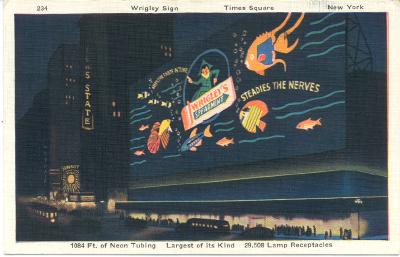
| Wrigley’s Gum built its first block-long sign in 1917. In 1936, Wrigley's built the mind-boggling sign shown above. It was a block-long sign featuring over 1,000' of neon bubble-blowing angelfish, fighting fish, and other exotic tropical fish as well as the Wrigley’s Spearman. The fish were 12’-43’ long and eight stories tall. Unique neon colors were developed for specifically this sign. In 1942, this and all Times Square signs were turned off for World War II. Wrigley's has a contemporary sign just a block south of where this one was. For more, see these websites: 1 and 2. |
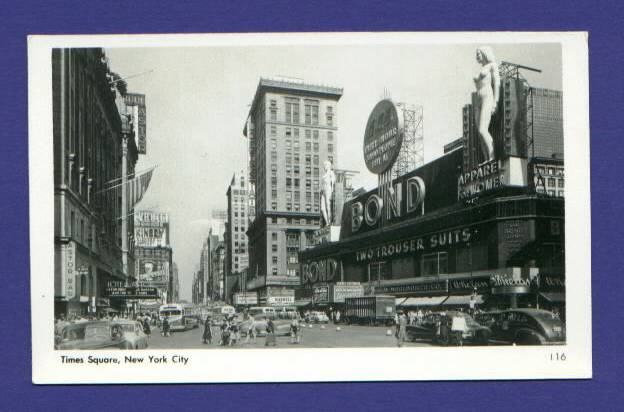
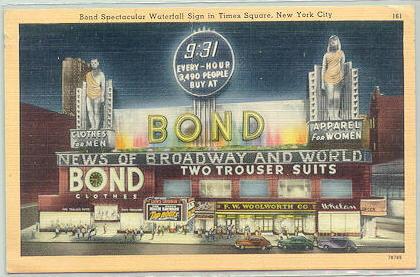
|
Bond Clothiers, dubbing itself the
“cathedral of clothing”, moved in below the Wrigley’s sign in 1940. The Bond
sign only lasted six years but was one of the greatest sign spectaculars
ever. It was designed by Douglas Leigh in 1948 and had nearly 2 miles of
neon. The sign had two 7-story tall nude figures, a man and a woman, as
bookends. When complaints were lodged by Astor Hotel guests across the
street about their indecency, gold neon robes were added.
Between the nude figures,
there was a waterfall which was 27’ high and 132’ wide which
recirculated 50,000 gallons of water. In winter, antifreeze was added to
keep the water moving. Beneath the waterfall was a 278’ zipper sign with
scrolling messages. The Bond zipper was made up of over 20,000 light
bulbs. Above the waterfall was a digital clock with the wording “Every
Day 3,490 People Buy at Bond”. The Bond signage went dark and dry in
1954.
The retail space below housed many businesses over the years, including a Loews movie theatre, the Roundabout Theatre, Whelan Drug, and Toffenetti's Restaurant. In the 1980s, the former casino space was used a disco and nightclub which claimed to be the world's largest (it could hold 1,800 people). At some point, this building that was referred to as the Bond Building became known as the Bow-Tie Building -- a reference to the shape created by the intersection of streets of Times Square. For more, see this website. |
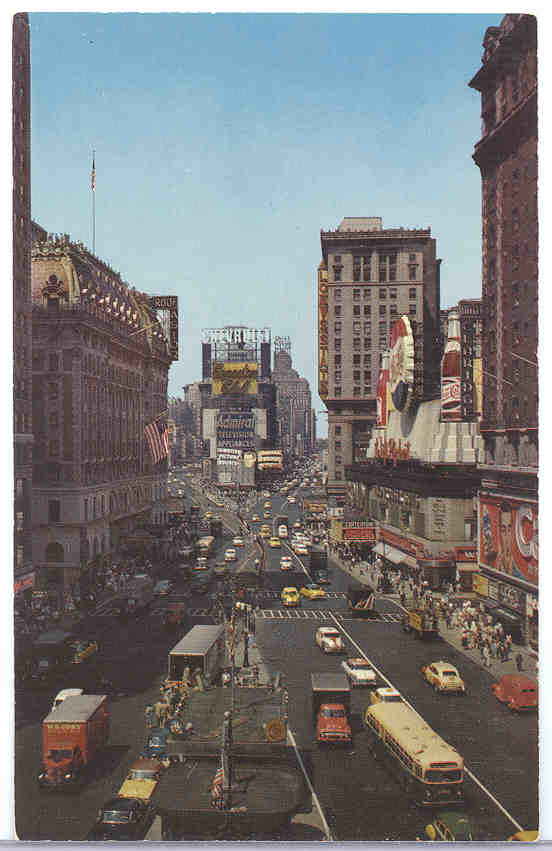
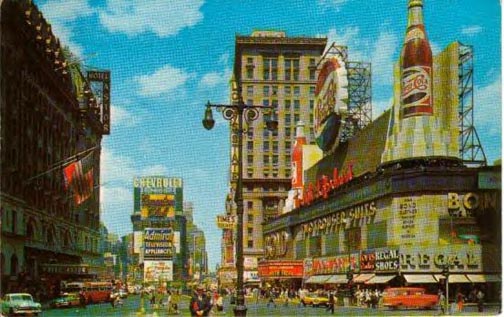
| In 1955, Pepsi took over the sign site and restarted the waterfall. It replaced the nudes with two 50’ Pepsi bottles and the circular clock with a bottlecap. In 1960, the waterfall was stopped as it was deemed too expensive. Pepsi vacated the space in 1966 but I’m not sure what replaced it. In the 1980s, Camel took over the spot and put two giant cigarette packs where the Pepsi bottles were. After that, the façade became a mishmash of various signs. |
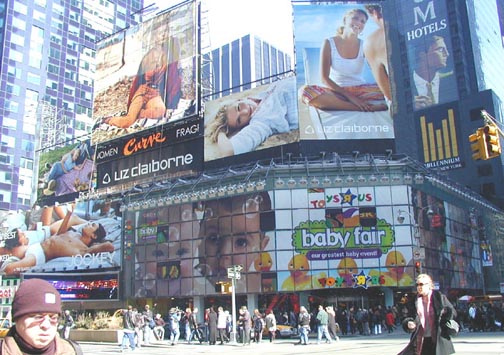
| The Bow-Tie Building underwent such substantial renovation in 2001/2002 that its upper deck advertising façade is no longer recognizable as the previous home of Bond's or Pepsi. The building is currently occupied by Toys 'R' Us, the Swatch Watch Company, Foot Locker and nine billboards which include long-time advertisers Claiborne and Jockey International. The Toys 'R' Us interior features a 60' tall ferris wheel and a 20' tall animatronic dinosaur. Its four-story exterior signage system features 165 individual scrolling panels which can display up to eight different images each. The signs change every twenty minutes with different advertising and a "clear" which allows the spectator to see the store's interior. For more, see these websites: 1, 2, 3, and 4. |
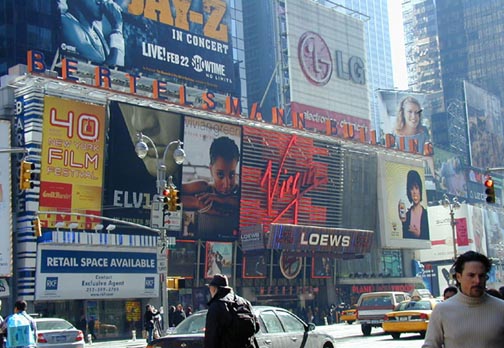
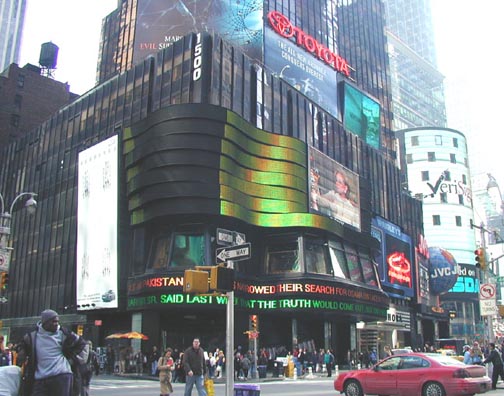
| One block
north of the Bow-Tie Building is the Bertelsmann Building. This is
Bertelsmann’s U.S. headquarters (they are the third largest media company in
the world, owning BMG, Bantam, Random House, and Double Day). The building
was erected in 1990 with retail space featuring a Virgin Megastore (the
largest in the world), a Planet Hollywood restaurant, and a Sony fourplex
theater. For more, see these websites:
1
and
2.
One block south of the
Bow-Tie Building is 1500 Broadway which houses ABC Studios. The
building was erected in 1972 and ABC Studios moved in in 1999. ABC's
signage includes a giant video screen and news zipper. ABC pays over $7
million in rent a year for its location for Good Morning America (the
competition for NBC's Today Show over at Rockefeller Center). ABC also
uses its space as a newsroom and the headquarters for Dick Clark's New
Year's Eve extravaganza. For more, see these websites:
1
and
2. |
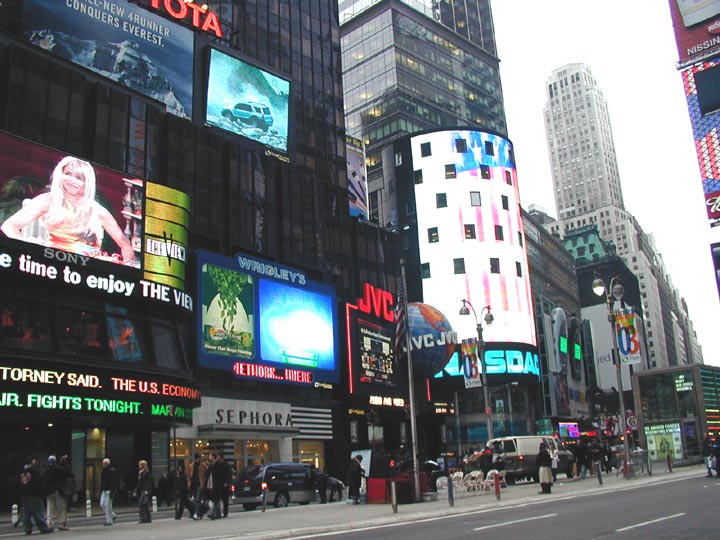
| The NASDAQ sign at 4 Times Square (the Condé Nast Building) was unveiled in 2000. NASDAQ's MarketSite Tower features an eight story (120’ x 90’) cylindrical sign. It is the largest sign in Times Square, as well as the most technologically advanced and the most expensive. It has a palette of over 16 million colors and over 8,000 panels which display ads and stock info. The 30 cutout windows allow light to enter the building. Plans are also in the works to add huge, new LumaSigns to the top of 4 Times Square. For more, see these websites: 1, 2, 3, 4, and 5. |
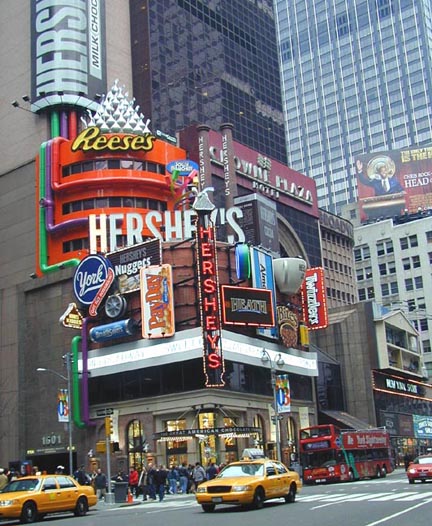
| The
Fleet Bank sign is just across 46th St. from
Howard Johnson's. It features a giant cash machine which dispenses cash
and a credit card. Its ATM screen is used for advertising.
The Hershey signs and
retail store were built in 2002. Located in the Crowne Plaza Hotel
building just north of Times Square proper, this is Hershey's first
retail store outside its homebase of Hershey, PA. The 15-story (215' x
60') spectacular features chocolate bars, giant Hershey Kisses, a
steaming cup of cocoa and smokestacks resembling those back at its
manufacturing plant. For more, see
this website. |
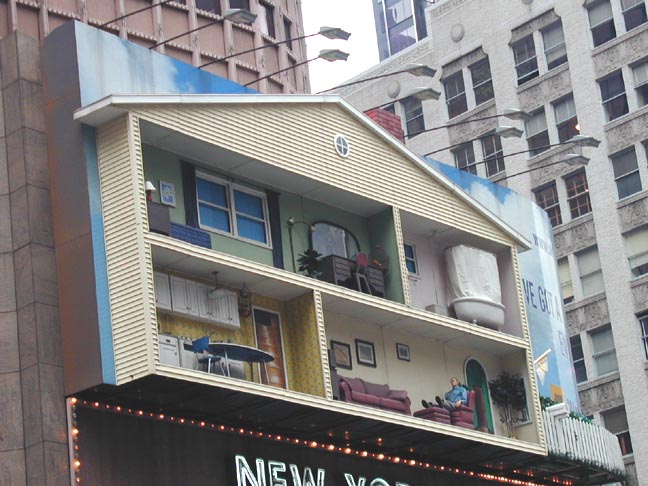
| The Washington Mutual sign wraps around the building above the New York Sports Club just north of the Hershey signs. Washington Mutual is a mortgage lender and has another sign at 1 Times Square. This huge billboard features a 3-D cross-section of a house with furniture, a man on a recliner, and white picket fence. For more, see this website. |
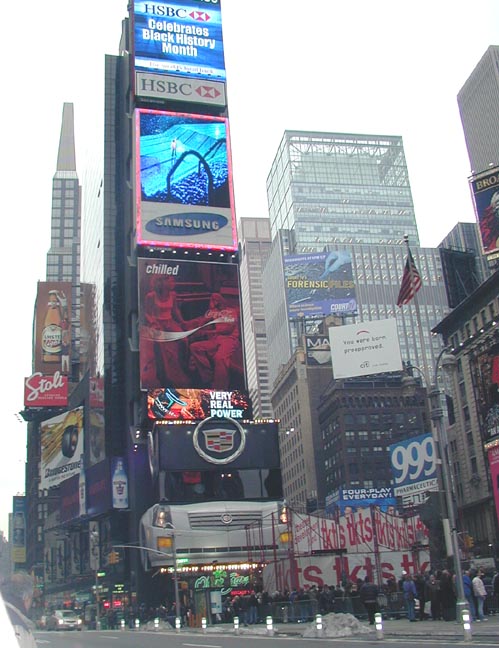
| At
opposite ends of Times Square are two towers laden with signage like
electronic totem poles. The northern tower is known as 2 Times Square
which is most famous for its sorely missed Coca-Cola signs which were
there from 1920 until 1999. Coke's first 2 Times Square ad appeared in 1932.
From 1991-2002, Coke's fifth spectacular featured a 55 ton, 42’ tall neon
bottle on ice with a moving cap and straw. The sign cost over $3 million.
Coke's latest sign will be unveiled July 1, 2004. At a cost of $6.5 million,
and weighing in at 30 tons, the sign will feature the latest technology. For
more, see these websites:
1
and
2.
General Motors has been
advertising Cadillacs at 2 Times Square since 1998. Its fourth and most
recent spectacular was built in 2002 and features a giant, 2-story high
front end of a Cadillac CTS. For more, see these websites:
1,
2, and
3. |
| 1
Times Square is the southern tower
of Times Square where the crystal ball is dropped every New Year’s Eve. The
25-story skyscraper was built in 1904 as the New York Times Tower. The
tradition of dropping a ball for public gatherings on New Year's began in
1907. The first zipper message sign was created here in 1928. In 1996, the
building was sold and marketed entirely as a sign tower. Today, 3 of the 4
sides of the building are completely covered with signs. For more, see these
websites:
1
and
2.
The Budweiser sign, at
1 Times Square, features a 40' mechanical bottle of beer that tips to
the side to reveal an advertising video screen.
The 1 Times Square Nissin Cup O' Noodles was created in 1996 and is an “oldie” by Times Square standards. The cup is 60’ tall and continues the tradition of using steam in Times Square signs. The original steaming sign was the 1933 A&P coffee cup. It was followed by the Camel sign (1941-1966) which featured a cigarette smoking man who blew 10’ smoke rings every four seconds. In the 1970s, the Presto iron and Right Guard deodorant can signs used steam. In 1992, there was another A&P coffee cup. |
| The Planters Nuts sign is a recent addition to the side of the Marriott Marquis Hotel. It features a giant 3-D mechanical can which tips to pour out a handful of nuts. Planters' tradition of Times Square signage goes back to 1916. A giant neon bag of nuts was once located at 2 Times Square. Another sign featured a Mr. Peanut with a pouring, animated 22' long bag of neon nuts which tumbled towards pedestrians below. |
|
Websites: Camel sign (gone) Kleenex sign (gone) Concorde sign (gone) Artkraft Strauss Times Square Live Webcam Times Square Business Improvement District various Times Square signs past & present: 1, 2, 3, 4, 5, 6, 7, 8 Sincere thanks to www.agilitynut.com |
No comments:
Post a Comment
Please leave a comment-- or suggestions, particularly of topics and places you'd like to see covered